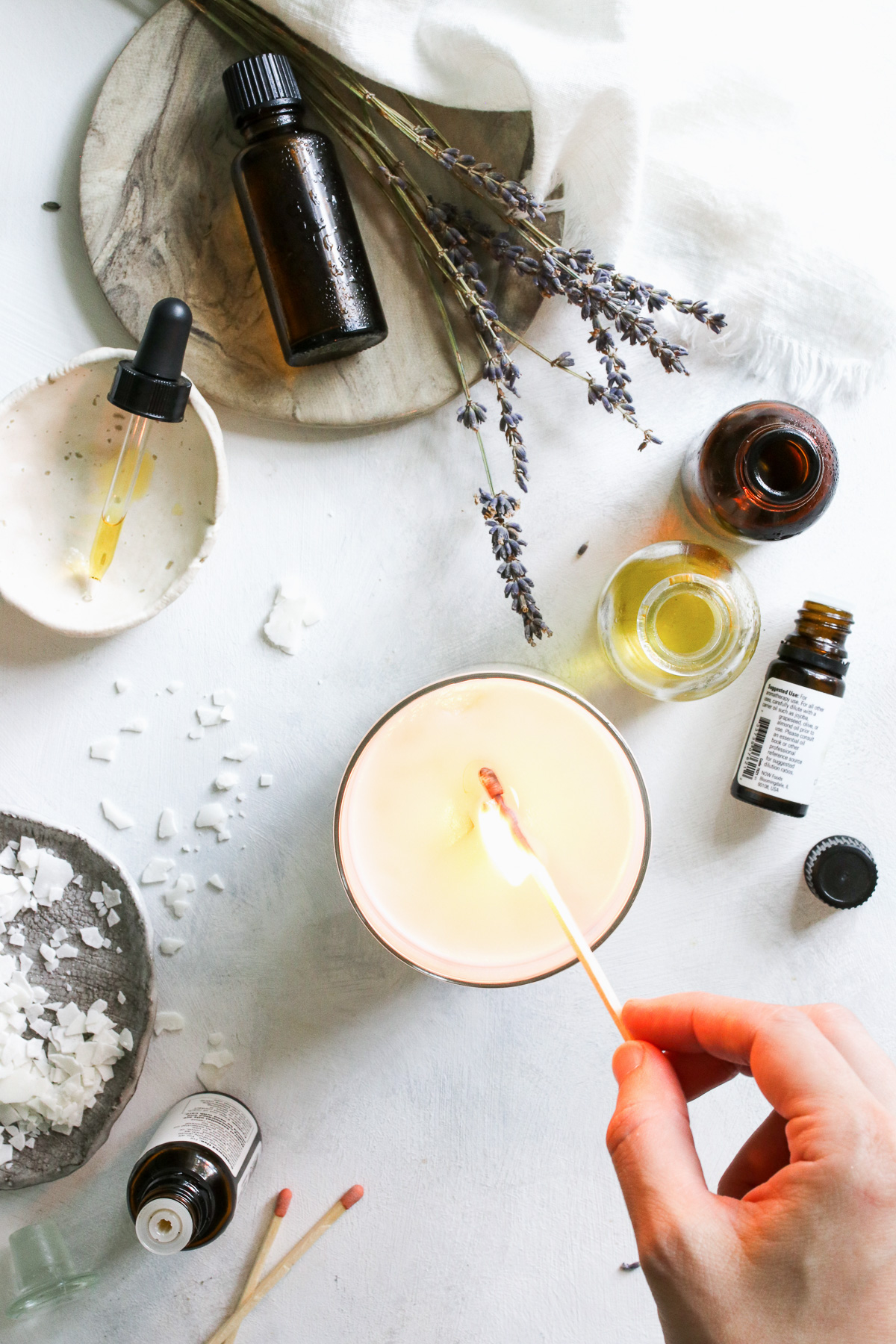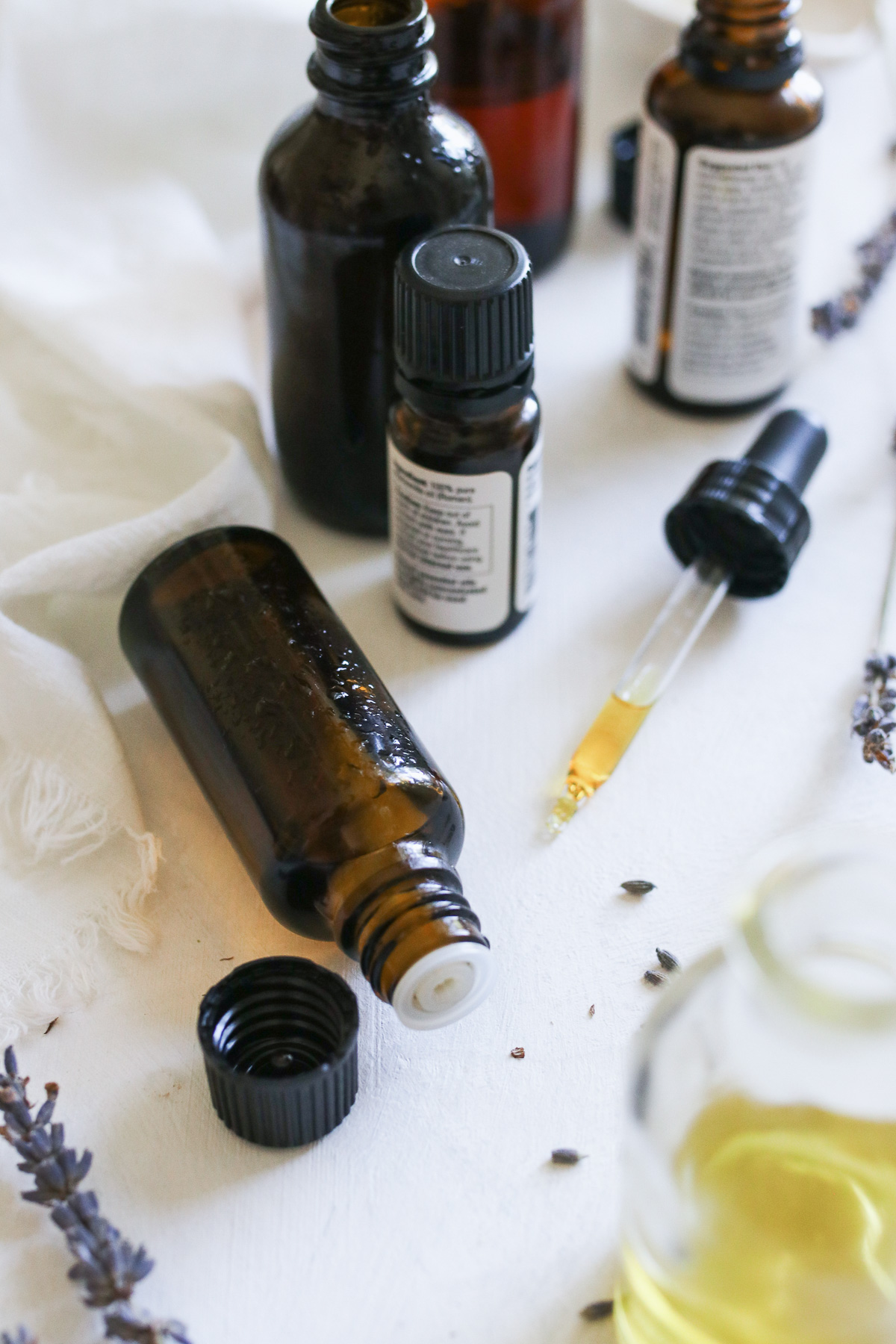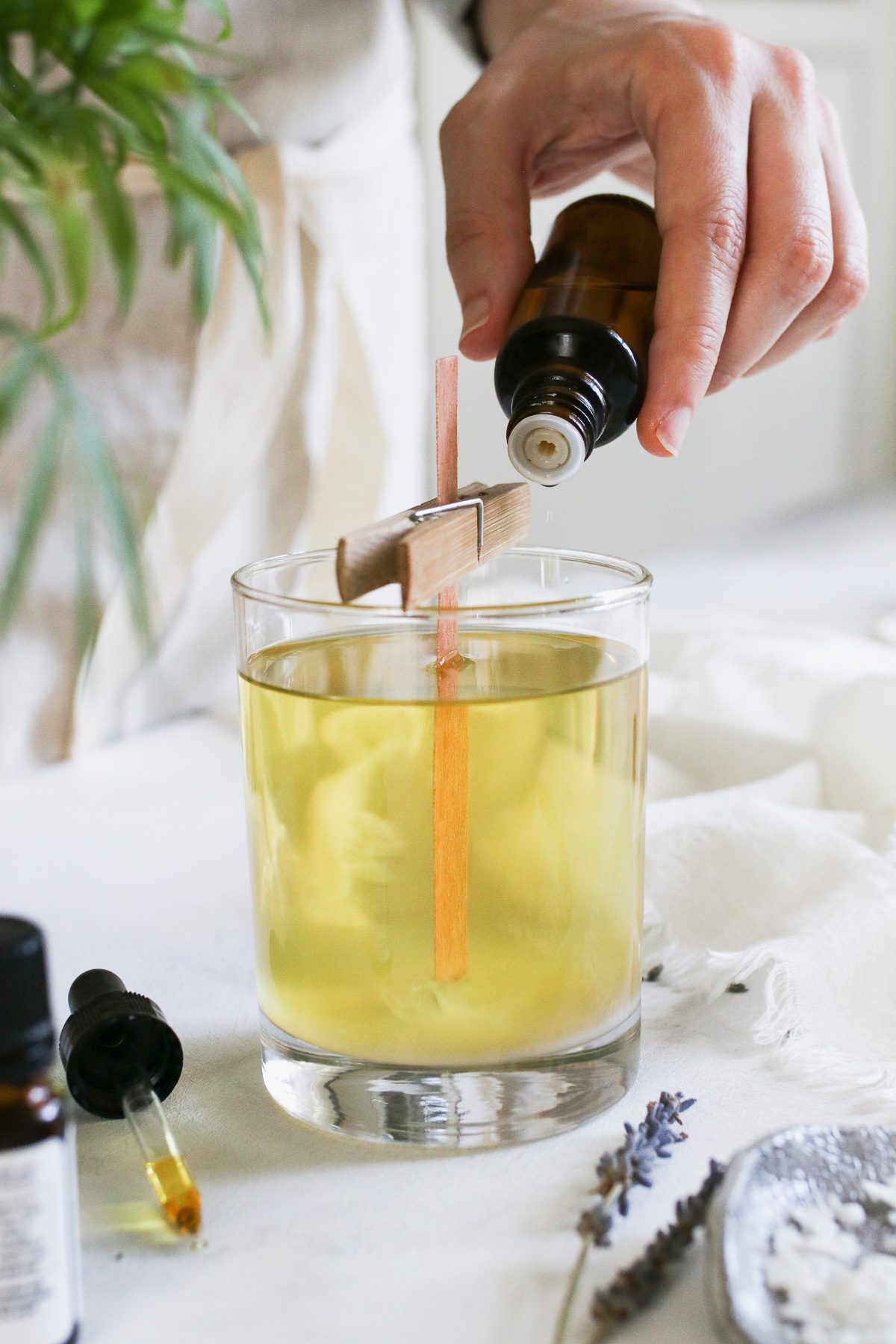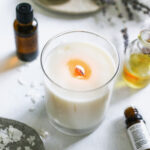There are few things more life changing than a good candle. Just light one and I’m immediately transformed into a home-maker, an amazing chef and a woman who has her act together. Plus, my house looks impeccably clean and perfectly decorated to boot (my husband might disagree—so let’s leave him out of this). Jokes aside, with all this free time on my hands lately, I’ve been finding huge amounts of joy in making my own all-natural essential oil candles.
There’s just something about the soft glow and subtle aromatherapy that comes with making your own candles.
But if you’ve ever made candles, you’ll know that they don’t always turn out perfect right out of the gate. Because essential oil candles aren’t loaded with fake scents, they might not be as fragrant as you’re expecting. Or if they do have a fragrance, you might notice the scent start to fade over time. But that’s a good thing.
Fake candles may smell good but they’ll do a number on your lungs and heart [source]. And if they use paraffin wax and metal wicks, they can crank out toxic substances, such as heavy metals and petroleum by-products, which have been shown to cause things like cancer and organ damage.
Trust me, it’s not worth the ick factor. Luckily, there are a few ways to boost the scent and get more aromatherapy out of your candles. Read on to learn how to choose the right wax, measure your oils, and make inexpensive, fragrant candles that beat the heck out of the store bought variety.
How to Make Essential Oil Candles
Like with most things, the quality of your candles depends heavily on the quality of your ingredients. Especially in the world of essential oils, fragrance varies by brand and purity. So, if you haven’t had much luck making candles that actually smell like anything, your ingredients might be to blame.
Before you start making your candles, take a look at the quality of your ingredients and see if you can’t improve right out of the gate.
1. Choose a slow-burning wax
While you might not think about it, waxes hold their scent differently. Some, such as beeswax, burn slowly and release a soft scent of their own. Others, like paraffin wax, are inexpensive and unscented, but they burn quickly.
Since essential oils are naturally less fragrant than chemical scents, you need to choose a wax that retains scents longer and releases them slowly into their air.
That’s why I recommend using soy wax.
Soy wax burns slower than paraffin wax, so your candle lasts longer. And it burns cleaner, resulting in less soot and smoke in the air. Not only that, but soy wax holds onto natural scents longer and releases them slowly while the candle burns, so your candles smell better, longer.
2. Choose a hot-burning wick
Soy wax is great at holding onto scent and releasing it over time. But it doesn’t get very hot, meaning it doesn’t release a ton of scent as the candle burns. For that you’ll need a hot-burning wick.
Hemp wicks burn hotter than cotton ones so they release more oil into the air as the candle burns. Make sure to choose all-natural wicks, like these, that don’t have a metal center or a paraffin coating.
But if you’re trying to save money and you already have some wicks on hand, just use whatever you have (that’s what I did). You can always add more oil to your candles to boost the scent, if needed.
3. Pick strong essential oils
Personal preference is important when making candles. But so is the potency of your oils.
Mellower oils, such as ylang ylang and sandalwood, are great for aromatherapy, but you might find their scent lacking when it comes to candles. Instead, choose oils that have a strong, noticeable scent that won’t dissipate as much over time.
My favorites are:
- Sweet Orange
- Eucalyptus
- Rosemary
- Cinnamon
- Pine
They’re not the soft, floral scents most of us think of when it comes to candles, but you’re guaranteed to get a whiff whenever you light it.
Feel free to mix and match your oils, especially if using a softer fragrance, to make sure your candle still has some scent. And if you have kids or pets, always do research beforehand to make sure your oils are safe to use.
4. Use more oil than you think
One of the biggest problems I see when making essential oil candles is not using enough oil to get a noticeable scent. I get it—oils are expensive! But since they don’t smell as strongly as synthetic fragrances, you need to compensate by using more of them. As a starting place, I recommend:
2 teaspoons oil for every 4-ounces melted wax
This ratio will give you a roughly 6% dilution, which is said to be the optimal amount for scented candles—but you can add more if you want. More oil will give you a stronger scent.
Feel free to adjust this ratio for different container sizes (ie. 4 teaspoons for an 8-ounce candle, etc.) and mix-and-match oils to layer fragrances.
5. Add oils at the right time
If the wax is too hot, it can destroy the active compounds in your oils and dampen the scent. Too cool and the oils might not evenly disperse throughout the wax.
The ideal temperature for adding your essential oils is 185 degrees F.
Place your wax in a double boiler and slowly melt it over low heat. Remove the wax and let it sit on the counter until it’s approximately 185 degrees (you can either use a candy thermometer or an infrared thermometer for this).
Once the wax reaches the ideal temperature, add your oils and pour the wax into your container (you can also add your oils after pouring the wax into the container—it’s up to you). Let your essential oil candles cool completely before lighting.
6. Keep the scent from fading
When your candle has fully cured, I recommend covering it tightly with a lid between uses so the scent doesn’t fade.
If you ever need to refresh the scent, simply melt the candle down and add more oil. To do so, simply place the candle in the freezer until the wax pops out. Then put the whole chunk of wax (wick and all) in a double boiler and gently melt it down. Remove the wick, add more oil and pour back into it’s container.
Not a fan of candles?
Try making these flame-free essential oil wax sachets instead.
How to Make Essential Oil Candles
Ingredients
- One 4-ounce metal or glass container
- Candle wicks hemp will throw off more scent, but cotton or wood will work, too
- 2 cups pure soy wax flakes add more as needed to fill your container
- Saucepan
- Old aluminum can for melting wax
- 2 teaspoons essential oil of your choice
- Old kitchen thermometer
- Clothespin or chopsticks to hold the wicks
Instructions
- Place the soy wax flakes in an old aluminum can (if it doesn't all fit, add as much as you can and add more as the wax melts)
- Fill a saucepan halfway with water and place the can of soy wax in the center. Allow the water to simmer until the wax melts completely.
- Remove the can and place your kitchen thermometer in the hot wax. Check the temperature every few minutes until the wax cools to 185 degrees (it doesn't have to be exact, but a slightly lower temperature is better than higher).
- Add your essential oils and stir to combine.
- Place the wick in the center of container and use a clothespin or chopsticks to keep it upright.
- Pour the wax into the container and allow it to cool for several hours, or overnight, before lighting.





handfullcraft says
Hey Stephanie,
The article is really informative and helpful for new candle makers like me.
I would appreciate it if you guide me more about selecting the scent for making the home-based candle.
Can you tell me some step-by-step selection guide for scent and the strong color for soy wax which can also be used for wax bees.
Again, thank you for the guide.
Elizabeth Strauss says
I love the idea of creating personalized candles with unique scents at home. The detailed step-by-step instructions make it seem so doable even for beginners like me.
I’m curious to know, what are your favorite essential oil combinations for candles? I’m thinking of making some as holiday gifts, and I’d love suggestions for cozy, festive scents. Also, any tips on where to source high-quality essential oils for this project?
Thanks in advance. 🙂
Daria Patrunjel says
Candles as gifts sounds lovely! You might like the combination of sweet orange + cedarwood, plain ginger or balsam fir like we used here: https://hellonest.co/layered-scent-diy-holiday-candles/
We like using essential oils from NOW, Aura Cacia, Plant Therapy, Gya, Healing Solutions to name a few.
John McGowan says
Paraffin wax is one of the most popular waxes used in candle making, and it is considered to be a safe and non-toxic option. Paraffin is a petroleum-based product that has been used for over a century. It is a colorless, odorless wax and is the preferred wax of many candle makers due to its excellent burning properties.
Although there has been some controversy over the safety of paraffin wax in recent years, many studies have demonstrated that it is non-toxic when used properly. The National Candle Association, a trade association for candle manufacturers, reports that paraffin wax is non-toxic and safe for use in candles and other personal care products.
Furthermore, the United States Food and Drug Administration (FDA) has approved the use of paraffin wax as a food additive and as a component of cosmetic products. This indicates that paraffin wax is considered safe for use in contact with the skin and orally.
It’s important to note that there are some potential safety concerns associated with paraffin wax candles. For example, if a poorly made or improperly wicked candle burns for an extended period, it could release soot into the air. This could cause irritation to the eyes, nose, and throat, and in extreme cases, may trigger allergy or asthma symptoms. However, by following proper candle-making techniques, choosing quality ingredients, and burning candles in a well-ventilated area, you can minimize these risks.
In conclusion, when used appropriately, paraffin wax is considered to be a safe and non-toxic wax option for candle making. As with any other ingredient, it’s important to follow proper candle-making techniques and use quality ingredients to ensure that your candles burn safely and cleanly.
Daria Patrunjel says
Thanks for your input!
Abeer says
I have a question about sweet orange essential oil. The flash point is 48c how can you add it in 80c without evaporate
Renee Bishop Davis says
Some sites say don’t use peppermint essential oil in candles because it can start a fire , others say it is safe to use essential oil in candles, I have some that shows CAN BE USED IN SOAP AND CANDLES, so what do I believe? I’m new and need advise
Davey Bartels says
I followed this recipe, but with beeswax and a tiny bit of coconut oil.
My flame looks normal, but after a while the flame stays very close to the wax (low flame). The flame is lower than the length of the hemp wick. It doesn’t go out, but it looks very odd and doesn’t create much light.
Does anyone know what this means?
Narciss says
What brand has the best candle essential oil?
Emily Maulucci says
This article is very helpful!! I am trying candles for the first time and would like to mix two essential oils together. I have 8oz candles with Soy wax 464 (from Amazon). I hope it applies to this one as well. With your recommendation 2tsp for 4 oz, is that total or 1 tsp one scent and 1 tsp another scent. I am assuming for 8oz, I would go up to 4tsp?
Thank you for any help!!!
Susan says
Excellent instructions! I want to begin a business how good an idea it is?
Linda galloway says
Hi how much in total of essential oil would i use if blending oils… im thinking if i use say 50g wax i would add 25g oils in total? Tia
Hannah says
Hello,
I hope my question doesn’t sound stupid but if I have multiple essential oils at different flash points that i’d like to add to 464 soy wax or any soy wax in general, is it best to add them separately according to their flash points? So for example, with sweet orange EO (flashpoint – 50C), cinnamon leaf (flashpoint 80C) and Vanilla (flashpoint 80C) should I add the cinnamon leaf and vanilla Essential Oils together once the wax reaches roughly 75C-80C then wait till it cools to 50C before adding in the Sweet Orange essential oil? Or would I have to mix the oils all together and add it at the lowest flashpoint of them all (50C)
Judy E says
Enjoyed your post . Close but you didn’t hit the subject; tarts or the small cubes !!! You gave me great advice for the quantity ratio , scent snd wax ! ! My first batch turned out pretty good, but the scent wasn’t strong enough for me ! I have 10 and 12 foot ceilings !! I’m going to keep trying to perfect my scents !!
Janice Navarro says
Very informative.. Beginner here!!! Thank you so much for this article. I love it! ❤️
Jenny Vides says
What are natural companies that sell essential oils for massage candles that are safe on skin? Made in the USA?
Jenny Vides says
Massage candles…
Janice Brown-Simpson says
If essential oil is added to soy wax at 185 degrees F, as suggested, won’t the oils evaporate because the oil is too hot? Wouldn’t this cause the scent of the candle to be faint?
Ruth Hadlock says
Hi. I have previously purchased soy wax and EricX pre-waxed cotton wicks. I used DoTerra eucalyptus oil. The flame is so tiny on all 3 candles I made (they are in a small 8-oz mason jar so it’s 2.5″ diameter). Do you think it will make a difference if I buy the wicks from your link – the hemp ones? The fragrance is nice so far but the flame is so tiny that the melt pool never reaches the edge. Thanks!!!
maria says
Loved to know more about candles with EO, please could you tell the the strongest Eo ? Thank you
Nicole Gardner says
Hi I used a sweet orange essential oil in my 464 soy wax and when I lit the candle it smelt of gas/lighter fluid. Why is this please?
Brandy says
Similar… same oil and wax and to me it smells like fire. I feel like maybe I’m just smelling the wick burn. I have friends that love it, so they say, but I hate it.
VINEVIDA says
Hi, thanks for the insightful article above on making homemade candles. My partner and I are trying to do the same, but it seems the hot throw isn’t quite that strong… We are using pure essential oils only (no fragrance) to keep things all natural. What do you recommend? You can check my post about the best essential oils for candles here https://www.vinevida.com/blogs/our-blog/10-best-essential-oils-for-candles-make-your-candle-and-bring-the-target-scent
Thanks!
Lacy Chapple says
Hi there, what kind of essential oils would you recommend to buy in bulk that won’t cost a fortune?
Eveline Pagnani says
Great article. Thank you so much. I only use pure essential oils in candles and love them. Unfortunately many will say they are toxic to pregnant women, pets and people with underlying medical conditions. Due to the negative hype, I was wondering if it might be a good idea to add a disclaimer to my candle care cards saying “If you are pregnant, nursing or under medical supervision consult with your health care provider”
Would appreciate your opinion. It is ironic though that synthetic chemicals in candles are so easily accepted, personally they give me headaches.
Jane Alcorn says
Hi Stephanie. I am a complete beginner and using RCX eco friendly coconut and rapeseed wax – would your advice for this kind of wax be the same as in your article please? I realise I must not be using nearly the right amount of pure essential oils and I’ve been adding at a much lower temperature ie 104F/40C.Best wishes, Jane
Amanda says
THANK YOU FOR SHARING. When experimenting with blends can you suggest the least wasteful way to do this? I.e can you determine blends without puring into wax?
M says
I’m working on making my own candles and I had a huge fire hazard with the first test batch I made…primarily because I used Tea Tree Oil in one of the candles in a much larger quantity than I should have. I’ve been researching on the internet looking for a resource that can determine which essential oils you should avoid for candles to not create fire hazards and I’m having trouble… your article was so well written I figured I should ask to see if you have any thoughts or suggestions! Thanks!
Brenda Harvey says
When pouring the scent take it completely off the fire to prevent the possibility of a fire. This is is what I was told.
Frankie says
All essential oils have a flash point. Some are too low to be using in candles.
Jess Hadfield says
This is a great article, it is very helpful. One correction though, if an essential oil brand is TRULY 100% pure…200 drops is about 10x too much, and that is not an exaggeration. Unfortunately the term “100% Pure” is not at all regulated and most essential oil bottles falsely claim this. However, 20 drops is more than enough for a 4oz candle if the oil is in fact, 100% pure, and free of ANY additional ingredients.
Iris Gonzalez says
what is the burning time on the candles?
Jamie Williams says
Has anyone mixed pine and lavendar? If so how did it turn out?
Nigel Titley says
I’ve mixed cedarwood and lavender (with geranium and ylang yland). That worked quite well.
Jon says
Hi Stephanie, thanks for the insightful article above on making homemade candles. My partner and I are trying to do the same, but it seems the hot throw isn’t quite that strong… We are using pure essential oils only (no fragrance) to keep things all natural. What do you recommend? And also, with pure essential oils, should we still be adding at 185F?
Thanks!
Jane Alcorn says
Hi Jon. I’m a complete beginner and wondering if you got a reply or have since found out more please? I realise from the article that i’m using far too little pure essential oil and also i am using a coconut and rapeseed eco friendly wax. I am surprised at the temperature of 185F to add the oils ie 85C as i was adding them at 40 – 45C. If you have any top tips for me that would me much appreciated! Best wishes, Jane
Heather says
I’ve read elsewhere that 185 f is TOO hot and to wait until it’s around 125 f, it might even be a tad cloudy, if it’s soy wax that is. Make sure you stir both directions a bunch like 30 to 45 seconds each.
Kristl Bridge says
I understand that some essential oils, when burned (even in a candle), are toxic and should not be used for candle making. Are the oils you mention safe for burning in a candle? Are there others that are safe to use?
FJ says
I am soooo thankful for this article! I have searched and searched the internet for some advice regarding making soy candles with essential oils. I have spent a lot of money purchasing ingredients, experimenting and failing. I mostly read that essential oils give poor scent throw, which is upsetting, then I came across this and all your helpful advice. Thank you!
Seema Singh says
Thanks for writing this great article! It’s very informative, and you included some great points to the equally great article. Now you can easily <a href="https://aquariangardenscolorado.com/diy-essential-oil-aromatherapy-bath-bombs/buy essential oils online store, Thanks again for sharing this post with us!!
Melanie says
In your photos it appears you have tunneling… is that something you know how to correct or is it just something that doesn’t bother you?
Sheila says
Hello, it’s because of the wick. I the candle is tunneling meaning it’s under wick.
Elaine M Crawford says
Hello! Have you gotten a reply to this question. Im having tunneling issues with all of my candles. I have adjusted the oils, the stearic acid (which I dont even this I need) Ive tried adding wicks…i either have extreme tunneling or the wicks burn out at the 4 hour mark and wont re-lite. (Im using 10 oz jars with a 3 inch mouth opening). If you have gotten any advice would you be interested in forwarding?
Thanks
Elaine
Catherine Whitt says
Hello Elaine,
If you are making container candles you do not need stearic acid. Stearic acid raises the melt point of the wax and hardens it, it is most commonly used as a hardener to create wax melts or make pillar candles. I would suggest leaving out the stearic acid completely and if issues are still arising to try 2 wicks.
Sarah says
Great article! The link that leads to Amazon soy wax chips… is that the brand you recommend? Or did you put that link just to show what wax chips are? I’m looking for the perfect soy wax for my candles.
Stephanie Gerber says
Yes, those are the ones we use.